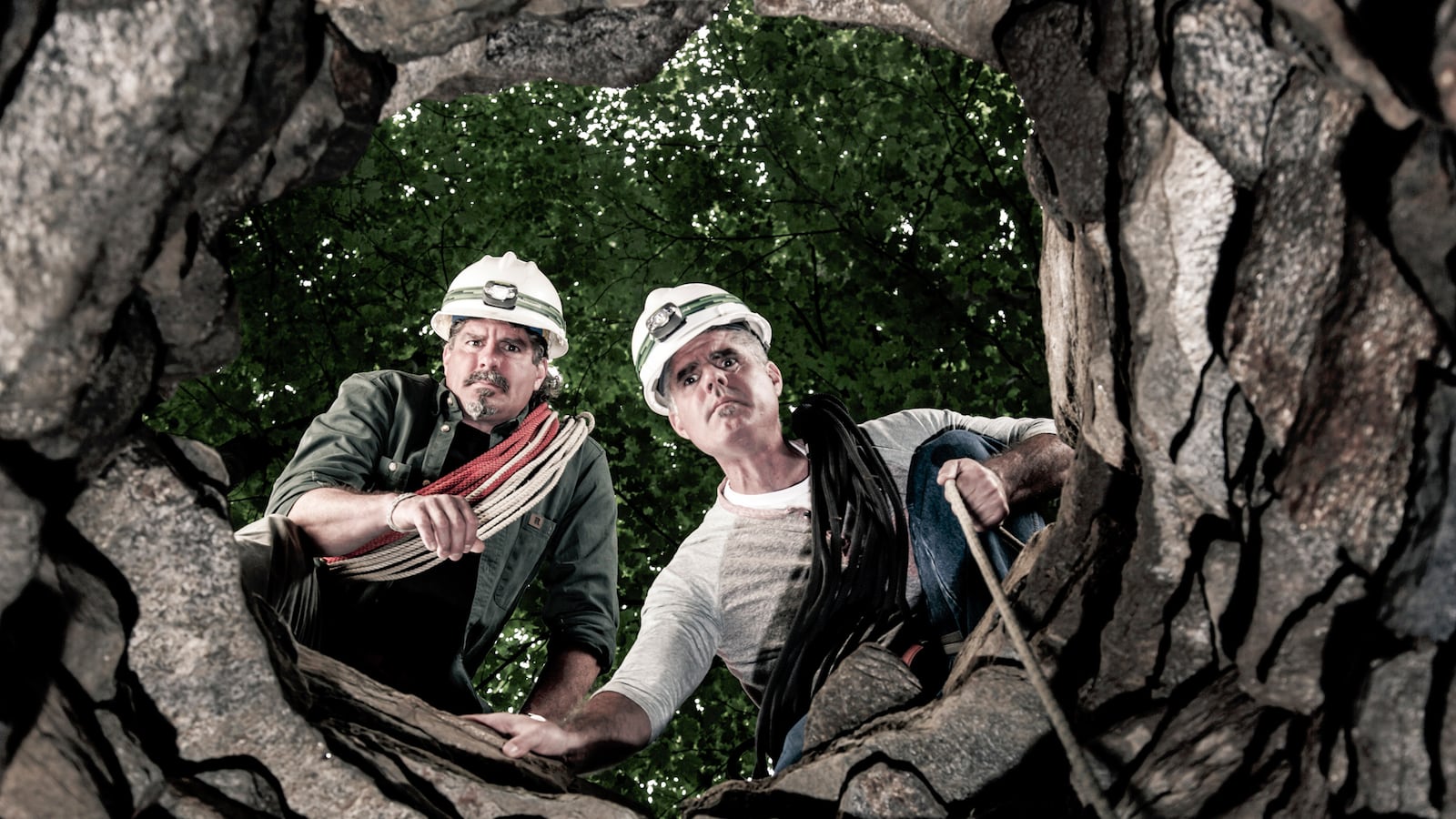Jim Vieira isn’t convinced that giants once roamed North America, but he’s willing to stake years of research and his professional reputation on finding out.
The 48-year-old Massachusetts-based stonemason has spent seven years scouring the country for evidence that an abnormally tall race of human-like creatures with double rows of teeth lived here many thousands of years ago. He explains his work is of the historical detective variety, as he digs into accounts as recent as 100 years ago and mythology tracing back to early civilizations that hint at a lost race of giants who once roamed the earth. His education in economics and training in stonework has little to do with the bones he hopes to find, but he has spent the past seven years making a name for himself as an amateur archaeologist, pouring through historical accounts and searching for mysterious stone structures in search of the skeletal remains of a forgotten civilization.
Vieira realizes this mission makes him the butt of an endless onslaught of skepticism and criticism. “You touch this subject as a professional you’re labeled a nut immediately,” he says. But he’s going mainstream with his theories, alongside his brother, Bill, as the subject of a new History Channel show, Search for the Lost Giants, which aired its second episode this week.
In 2007, Vieira got his first whiff of the mystery when he came across reports from the 1800s through the early 1900s of mysterious archaeological discoveries: bones from creatures taller than seven feet, skulls with double rows of teeth, large stone burial structures. They pointed to a common claim: that at some point in distant history there was a civilization of giants.
A few years later, Vieira found the evidence he was looking for to scale up his search. He went to the Memorial Hall Museum founded by local preservationist George Sheldon in Deerfield, Mass., and asked about reports that the museum once displayed the thighbone of a creature that was estimated to be at least eight feet tall. The curator produced a scrapbook made by Shelton with a collection of clipped articles from across the U.S., all boasting of giant discoveries. Evidence of the interest of this respected figure propelled Vieira on his quest.
Searching town records, scanning microfilm, and tracking down the descendants of the original discoverers, Vieira says he turned up thousands of similar reports, and the concept of a long-extinct race of giants began to ferment in his mind.
He surfaced headline after headline, emblazed with similar claims: “Giant Skeletons Found” in The New York Times in 1902; “Bones of Giant Race Are Found by CCC Diggers” in a 1934 Miami Daily News; “A Giant’s Remains in a Mound” also in the Times in 1883. Scans of many of these have been amassed by Vieira on his Facebook page, Stone Builders, Mound Builders and the Giants of Ancient.
“We have the reality that either giants roamed the earth or thousands of people [are] lying,” Vieira says.
The only thing that’s missing? Evidence.
According to Vieira, most of the bones unearthed had to be reburied in accordance with the Native American Repatriation Act. Others crumbled to dust after being discovered. Some gravesites were looted, built over, or otherwise lost.
In the filming of the History Channel show, the brothers have spent eight months scouring the country—from Catalina Island, CA, to Martha’s Vineyard, Mass.—for physical evidence.
What they’ve found, so far, is stonework scattered across New England that points to living structures and possible tombs of this enigmatic race. One of them, an ancient underground stone chamber, is being investigated by Vieira alongside a team of UMass archaeologists.
Around the world, similar theories and bits-and-pieces of evidence have surfaced. In South Africa, paleoanthropologist and National Geographic explorer Lee Berger is studying an array of bones that he believes indicate that a race of seven-foot-tall pre-humans existed around 400,000 years ago. “Everywhere we find them we find them enormous,” he told a Cambridge University blog called The Naked Scientists. “These are what we call archaic Homo sapiens. Some people refer to them as Homo heidelbergensis. These individuals are extraordinary, they are giants.”
Without Vieira having found an actual bone or skeleton in the sites he is investigating, there’s no chance the scientific community will get behind his claims, even a little bit. But the amount of second-hand evidence, Vieira says, is too great to believe that nothing more solid will show up.
“The only thing that’s going to solve this case is physical evidence, and it seems mind boggling to me that there are so many accounts and so little physical evidence,” he says. “Physical evidence is the holy grail of giantology.”
Naturally, the skeptics are out in abundance. Vieira dumped his personal Facebook page a few weeks ago, partly in anticipation of more backlash that will come with the show. He describes the battlefield he’s entered as “like trying to get in the middle of politics and religion—it’s a real landmine.”
The critics came out in force after Vieira did a highly watched TEDx talk last year. TED organizers eventually removed his video from the Internet after they decided it didn’t meet their scientific standards.
The Center for American Archaeology did not return requests for an interview, but an expert with the organization evaluated Vieira’s claims for TED, writing: “I can assure you that the archaeological Woodland and Mississippian populations were not giants.”
Norman Muller, the conservator of the Princeton University Art Museum, who has been following the research, isn’t convinced by Vieira’s claims, either. “I don’t buy it,” he says, “Period.”
“For evidence I would need to see a number of 8-10 foot skeletons. Not just one extremely long one, since Robert Wadlow [the tallest man in history] was nearly 9 feet tall,” Muller says. “And where are the skeletons with double rows of teeth?”
In conversation, Vieira doesn’t seem like a nutty conspiracy theorist; he comes off as an obsessively curious guy who doesn’t want to toe the scientific line but also would prefer to be taken seriously. “The thrust of what we’re doing is just make the case that further exploration is warranted and justified, not that we have all the answers,” he says.
Others are watching closely. Glenn Kreisberg, vice president of the New England Antiquities Research Association, which has spent half a decade looking into the stone structures in the area and of which Vieira is a member, is impressed with the investigation. He calls it “thorough, comprehensive, and compelling,” but contends that the newspaper articles can’t be taken as evidence. “Reports of ancient giant skeletons have abounded for years, many shown to be hoaxes associated with staged finds to gather attention to a particular community as a tourist attractions,” he says.
“If you're open minded, and believe all there is to know about science is not known and that much about our past is yet to be discovered, then the scientific possibility exists.” Kreisberg says. “Giants are the cornerstone of the myths, legends, and traditions of almost every culture on Earth.”
Vieira says he wants to convey a more multi-dimension version of reality to help break people in scientific fields out of the black-and-white way they’ve been taught to conduct their inquiries. Until he succeeds in this breakthrough, he’ll be plowing away with his clippings and backwoods trampling for a little bit longer.
“We’re going to give [it] our honest effort and if we can’t make a real compelling case, I’ll concede and say it looks like the mystery is unsolved. I would die of embarrassment if [it seemed like] I was trying to pull something over people,” he says, and pledges to give up his cause “if we don’t get our hands on physical evidence very soon.”
If that happens, a DVD of his History Channel show may be locked away for future generations to discover, decode, and then launch their own inexhaustible quests to unearth history’s mythical creatures.





